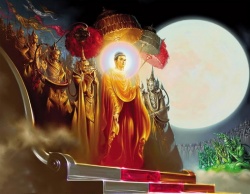Difference between revisions of "Nirodha"
m (Text replacement - "Category:Sanskrit terminology" to "{{SanskritTerminology}}") |
|||
| (One intermediate revision by one other user not shown) | |||
| Line 10: | Line 10: | ||
* the [[cessation]] of [[Dukkha]] | * the [[cessation]] of [[Dukkha]] | ||
* to confine, | * to confine, | ||
| − | * release | + | * [[release]] |
* "control or {{Wiki|restraint}}"; | * "control or {{Wiki|restraint}}"; | ||
| Line 19: | Line 19: | ||
[[Category:Kleshas]] | [[Category:Kleshas]] | ||
| − | + | {{PaliTerminology}} | |
{{SanskritTerminology}} | {{SanskritTerminology}} | ||
Latest revision as of 10:03, 2 September 2014
Nirodha (Pali, Sanskrit; Tibetan 'gog pa) — literally refers to the absence or extinction of a given entity. As the third of the Four Noble Truths, it refers specifically to the cessation of Dukkha (Suffering) and its causes; it is commonly used as a synonym for Nirvana.
In the context of the Four Noble Truths, nirodha refers to the cessation of suffering and the causes of Suffering. It is "the cessation of all the unsatisfactory experiences and their causes in such a way that they can no longer occur again. It’s the removal, the final absence, the cessation of those things, their non-arising." According to the Buddhist point of view, once we have developed a genuine understanding of the causes of suffering, such as craving (tanha) and ignorance (avijja), then we can completely eradicate these causes and thus be free from suffering.
Etymology
Nirodha can have the following meanings:
